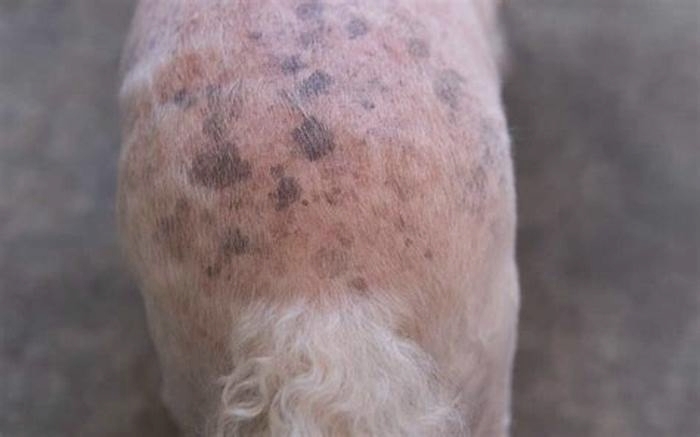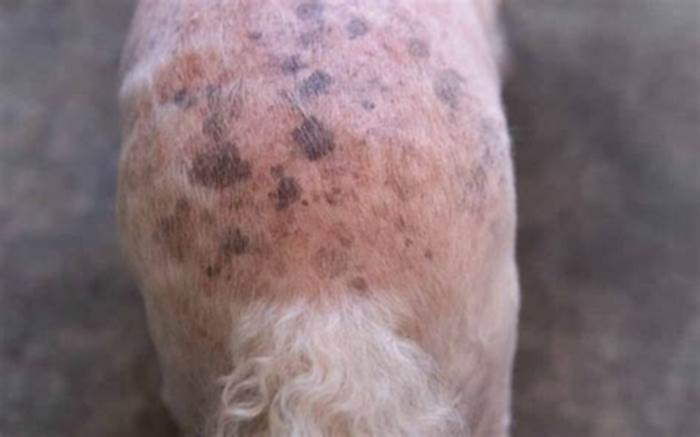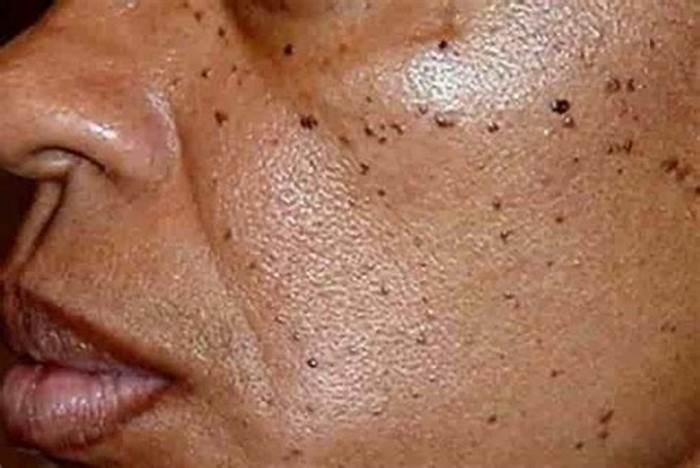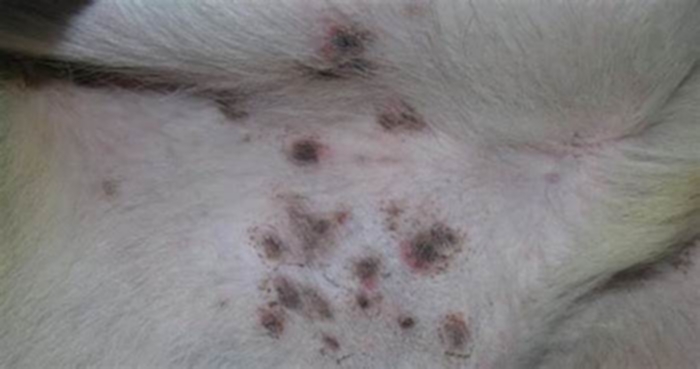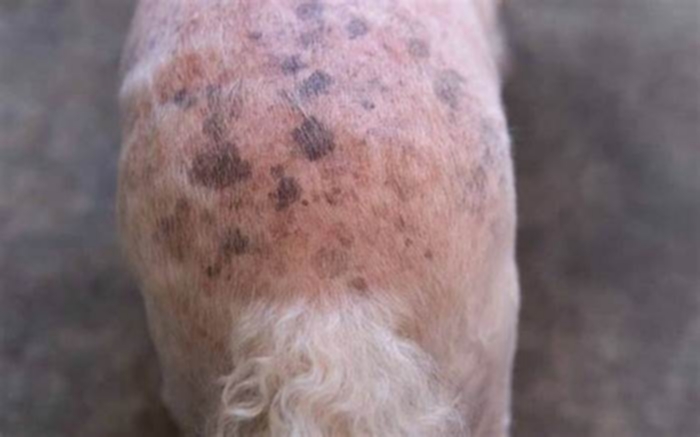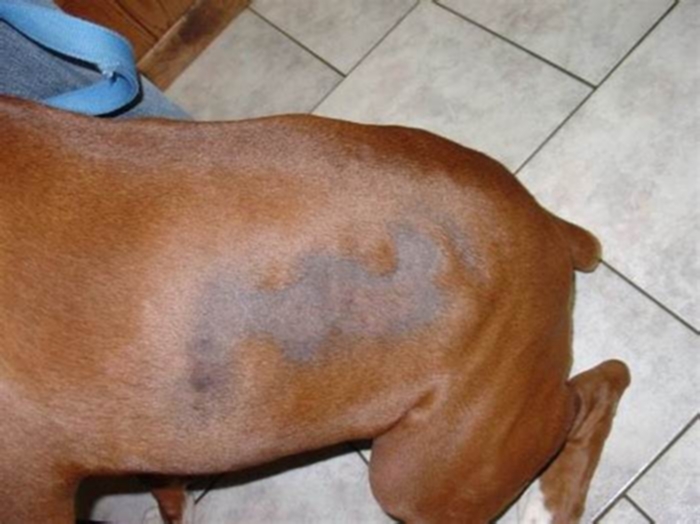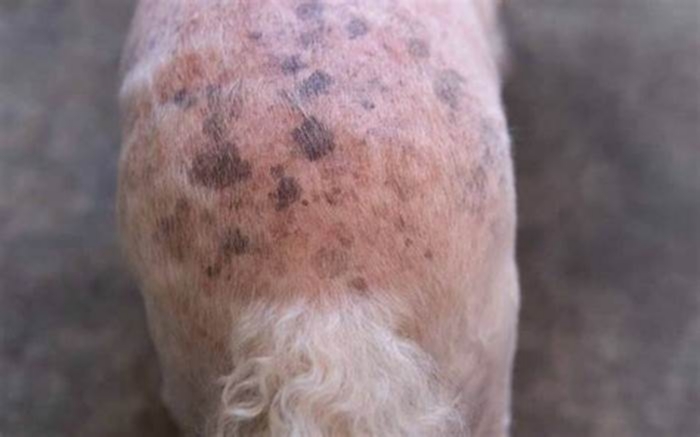How do you treat black spots on a dog s stomach
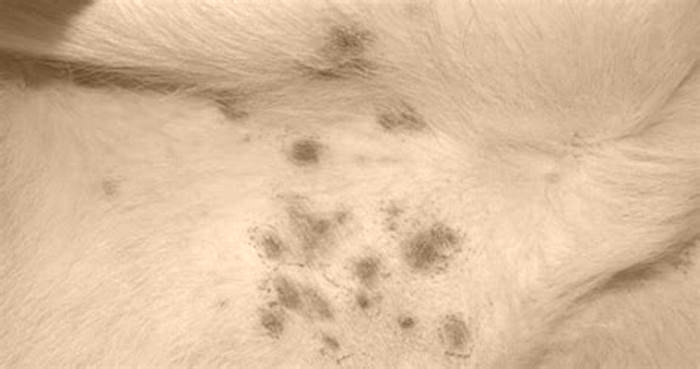
Hyperpigmentation: When a Dogs Tummy Has Turned Black
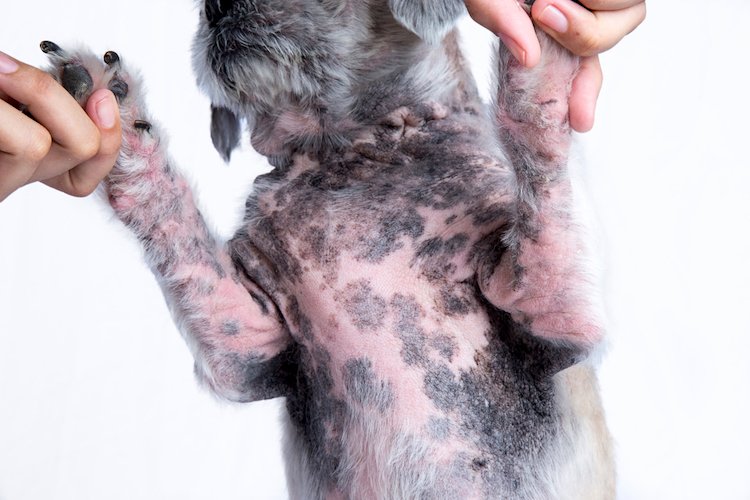
When a dogs tummy has turned black, and it used to be cute pink or white, some pet lovers get concerned. People often think this is a sudden change in skin color, but most cases of hyperpigmentation happen over time.
Perhaps its the light in the room on a particular day that causes you to notice the change, or that one time your dog turns over and says, Look, Ma, my pink belly has black spots now!
Most causes of a change in skin color on a dogs belly shouldnt cause worry. But there are always exceptions, of course.
What Is Hyperpigmentation in Dogs?
Hyperpigmentation in dogs refers to areas of skin that become darker than the surrounding skin. This can be due to an excess production of melanin or other pigments, and it often occurs in response to inflammation, irritation, or hormonal changes. The two types of hyperpigmentation in dogs are:
Primary Hyperpigmentation:
This is less common and may be genetic or idiopathic (of unknown cause). It tends to be a cosmetic issue rather than a sign of underlying disease. Dachshunds, Whippets, and other breeds can be predisposed to primary hyperpigmentation.
Secondary Hyperpigmentation:
This is more common and occurs as a response to some kind of skin trauma, inflammation, or other skin disorders. Secondary hyperpigmentation can be due to a variety of factors:
- Inflammatory Conditions: Such as chronic dermatitis, where repeated scratching or irritation leads to darkening of the skin.
- Endocrine Diseases: Like hypothyroidism or Cushings disease, which can cause changes in skin texture and color.
- Friction: Areas that experience constant friction, such as armpits or under the belly, may darken over time.
- Allergies: Dogs with atopic dermatitis or food allergies may develop hyperpigmented areas as a result of chronic itching and skin trauma.
- Infections: Fungal infections (like Malassezia dermatitis) or bacterial infections can cause inflammation and hyperpigmentation.
- Parasites: Infestations with parasites, such as fleas or mites (like those causing scabies or demodicosis), can lead to skin irritation and subsequent hyperpigmentation.
- Lick Granuloma: A condition where a dog persistently licks a spot on its body, causing inflammation, infection, and hyperpigmentation.
- Sun Exposure: Just as with humans, prolonged sun exposure can lead to hyperpigmentation in dogs, especially in areas with sparse hair.
Most cases of skin darkening in a dog are secondary to other skin conditions or metabolic problems such as allergy, infection or endocrine disorders.
Skin discoloration doesnt happen overnight there has to be some degree of continual trauma or exposure for hyperpigmentation on a dogs stomach or anywhere else to result.
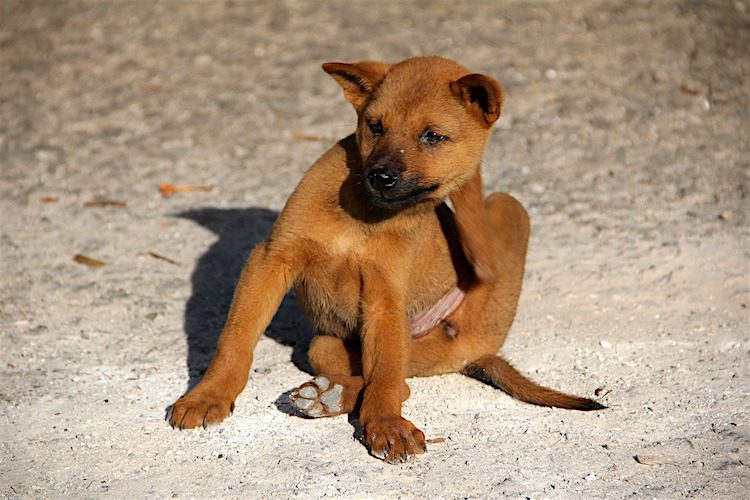
Allergies and Hyperpigmentation in Dogs
Hyperpigmentation is most often associated with chronic itching. This is called pruritus-induced hyperpigmentation (translation: darkening of the dogs skin caused by chronic itching).
You and your veterinarian have to manage the allergies causing the itching and chronically inflamed skin to treat the changes in skin color.
Although the skin may never return to its former light color, treating chronic skin conditions and the causes of itching and self-trauma is important for your dogs health and comfort.
At this point, you might be saying to yourself that you havent seen your dog bothering their belly for a long time, so itching cant be the cause of the hyperpigmentation. This is because the trauma, such as chronic licking or scratching or infected skin, could have occurred months before, and you are only noticing the color change now.
Think back to that redness that occurred last summer inside your dogs legs or when the dog spent a couple of weeks licking their belly in October. Perhaps these same patterns of itching occurred over months or years. The color change from that chronic trauma may only be visible now.
Skin Infections and Hyperpigmentation in Dogs
Skin infections can occur on their own or can be secondary to allergies. No matter the cause, if the skin is infected, it can lead to hyperpigmentation.
Skin infections, like allergies, can be chronic. Your vet will get to the bottom of this and treat accordingly.
- Bacterial and yeast infections are the most common causes of skin infections in dogs.
- Mange (demodex and sarcoptic mange) can cause the skin to darken. Demodex lesions are usually local. Sarcoptes usually becomes generalized. The discoloration can resolve once the mange is treated but will remain in severe cases.
- Ringworm (dermatophytosis) can cause temporary or permanent hyperpigmentation in dogs.

Veterinarians will ask themselves the same questions you might be asking yourself on the way to a diagnosis:
- Why is the dogs belly red or black? (Many causes are possible.)
- Why is it itchy? How itchy is it? (Allergies?)
- Why is it smelly? How smelly is it? (Yeast?)
- Is the dog itchy only at certain times of the year? (Allergies?)
- Do we have a thorough history on this dog since they were young? (Previous allergies or traumas?)
Once these questions are answered through history taking and diagnostics like skin scrapings, cytology, food trials and maybe even biopsy we will know how to treat the thing thats causing your dogs tummy to turn black.
If youve adopted a dog who now has quiet skin but has obvious areas of hyperpigmentation, its likely the dog suffered from skin trauma such as allergies when they were young.
Endocrine Disorders and Hyperpigmentation
Hypothyroidism, hyperadrenocorticism (Cushings disease) or sex hormone imbalances can cause hyperpigmentation. We generally have many other things going on with the dog than just a black tummy if the dog is hypothyroid or has another hormone imbalance.
Along with hyperpigmentation, these dogs can have large areas of fur missing, patchy fur loss, secondary skin infections, thinning hair, thin or thickened skin as well as changes in energy, thirst, appetite, etc.
Blood tests are required to diagnose endocrine disorders.
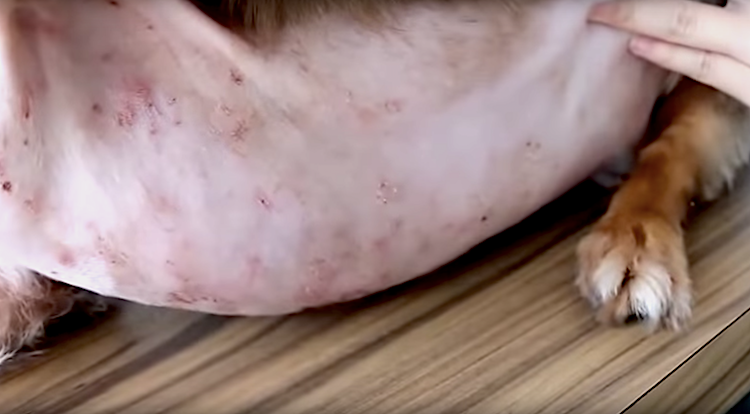
Dogs Skin Turning Black and Losing Hair
When a dogs tummy has turned black, thickening of the skin (lichenification) and/or hair loss (alopecia) can go along with hyperpigmentation, making the skin and fur look sad indeed.
Long, chronic skin allergies causing the dog to scratch and bite will cause the skin to become thickened (lichenified).
I see this most commonly in the groin area, the armpits and sometimes around the eyes and private parts, depending on where the dog is most itchy.
Genetic Disorders and Hyperpigmentation
- Dachshunds: Prone to a rare disease called acanthosis nigricansthat causes hyperpigmentation followed by alopecia and lichenification.
- Huskies and related breeds: Prone to alopecia X, a syndrome that causes hair loss and hyperpigmentation.
- Yorkies, Silkies and crosses: Prone to melanoderma, a skin anomaly that usually causes hair loss and hyperpigmentation of the ears as well as color dilution alopecia, causing fur thinning and darkening of the skin on the body.
Miscellaneous Causes of Hyperpigmentation in Dogs
- Dogs skin turning black after shaving? Post-clipper alopecia (translation: no fur regrowth after clipping or shaving) can result in hyperpigmentation. If fur does not grow back after grooming, extreme grooming or clipping due to surgery, the skin can become darkened in that spot. The darkening may fade with time, and the fur may grow back eventually after months and months. This is particularly true in Nordic breeds. Shaving close to the skin of those wonderful fluffy beauties, like Samoyeds and Akitas, is not recommended.
- Saliva from chronic licking can cause pigment changes of the skin and fur, particularly in dogs with light-colored coats. Think of the white Poodle with brown-stained feet. The fur as well as the underlying skin is darker from chronic licking. Foot-licking, usually due to allergy, can often be controlled or lessened but not always cured.
- Hyperpigmentation can be normal as a dog ages. Mild darkening of the skin from exposure to the sun and elements can occur, particularly in dogs with light or white coats.
- Any changes in hair cycle arrest, particularly in plush-coated breeds, can cause hyperpigmentation.
- Changes in hormones, including giving drugs like steroids or diethylstilbestrol (DES) for urinary incontinence, can cause hyperpigmentation.
- Dachshunds are hyperpigmentation mavens. This breed has a lot of pigment in their skin, and just about anything can cause discoloration. A black spot on the skin can result from even a small pimple!
- Deep scarring often leaves an area with no fur regrowth and hyperpigmentation.
- Many differentskin disorders, including cancers and growths, can cause hyperpigmentation. These dogs clearly have fairly severe lesions and are not simple cases of darkened skin.
This dog suffers from atopic dermatitis, which means shes very itchy and might scratch her skin enough to cause hyperpigmentation:
To pick up where we started and end here, the most common cause of hyperpigmentation in dogs is chronic licking or scratching (pruritic-induced hyperpigmentation).
Although you think you might be noticing your dogs black tummy for the first time maybe youre thinking Suddenly my dogs skin is turning black and smells or Why is my dogs skin turning black under their leg creases now? this is usually not the case. The changes are gradual and not a cause for emergency alarm.
If your dog is not exhibiting any scratching, licking or biting at themselves; has no obvious lesions on the skin other than the change in color; and seems normal in every other way, bring up the hyperpigmentation at your next vet visit.
References
- Hnilica, Keith A., DVM, et al. Small Animal Dermatology, 4th ed. Elsevier. 2016.
- Johnson, Kris. Skin Hyperpigmentation, Dog. VIN. April 2017.
- Miller, William H., VMD, et al. Muller & Kirks Small Animal Dermatology, 7th ed. Elsevier. 2012.
- Paoletti, Michael. Post-Inflammatory Hyperpigmentation, Dog.VIN. December 2017.

This pet health content was written by a veterinarian,
Dr. Debora Lichtenberg, VMD. It was last reviewed Jan. 22, 2019.
If you have questions or concerns, call your vet, who is best equipped to ensure the health and well-being of your pet. This article is for informational purposes only and is not a substitute for professional medical advice, diagnosis or treatment. See
additional information.
Black Spots on Dogs Skin: When To Worry
As a dog lover, you probably notice even the slightest change in your dogs behavior or appearance. Youre the one that is likely petting your dog all over and feeling their every nook and cranny. So, if you come across a change in the feeling or look of their skin, you will likely notice it.
If you see black spots on your dogs skin, the first thing you might want to do is panic, but we urge you not to. Black spots on a dogs skin are common appointments in veterinary offices, so your dog will be in good hands.
These spots can pop up anywhere but are most frequently near the underbelly and genitals. This condition is often referred to as hyperpigmentation. It can happen to any dog of any age and can allude to something else going on related to your dogs health, but its not always life-threatening. That being said, your dog might be due for some vet care.
Keep reading to learn more about black spots and hyperpigmentation on your beloved pet.
Black Spots and Hyperpigmentation
If black spots have begun forming on your pups skin, it could be due to hyperpigmentation. This refers to when your dog starts producing higher amounts of melanin, which makes their skins natural pigmentation darker. This might become most noticeable on dogs with lighter coat colors than on darker-coated dogs.
These spots can come from aging, intense friction in one area, or even sun exposure. For the most part, hyperpigmentation could be harmless. As with anything, youll want to watch to see if new, unusual, or worrisome behaviors begin. For example, if your dog starts scratching, licking, or rubbing those areas, there might be something else going on.
Hyperpigmentation: What To Watch Out For
Hyperpigmentation is usually a sign that something else is going on. There might be other symptoms that accompany hyperpigmentation, but its not necessarily a diagnosis. It is not a specific disease you can treat but a symptom itself. Your dog might have skin that becomes hyperpigmented due to several different reasons.
Along with black spots showing up, you might notice that the skin becomes irritated. It might become rough or red, with the possibility of hair loss. Its possible that your dog also experiences scaliness or itchiness around the black spot.
Some dogs experience hyperpigmentation that is moist, and others experience black spots that are very dry. Its completely random and might be dependent on the kind of dog and the specific situation.
When your dog is experiencing other symptoms along with hyperpigmentation, consult with your veterinarian to find out about underlying conditions.
Is Hyperpigmentation a Primary or Secondary Condition?
Hyperpigmentation is a secondary condition, meaning that it is a secondary effect. Its usually the result of something else. In many cases, these spots could form after skin trauma or due to the natural process of aging.
What might accompany black spots on a dogs skin is an underlying skin-related issue. If you can figure out the underlying problem, youll have a much easier time learning how to treat hyperpigmentation and ensure your dog is comfortable.
What Causes Black Spots?
Black spots can show up on a dog at any point. If you notice black spots on your dog, you shouldnt jump to the worst conclusion. First, consider if there have been any changes in their diets, behaviors, medications, or life that might be causing added stress or discomfort.
Some of the more common reasons why black spots might appear on your dog are:
- Trauma: When a dog undergoes trauma to a certain body part, either from an injury or surgery, they might experience hyperpigmentation. The skin cells will go into repair mode and will release more melanin to protect the damaged skin.
- Allergies: If your dog has an allergic reaction to something in their food or environment, it may cause black spots on the skin. You may not be able to cure them, but you can manage allergies to help soothe the skin.
- Aging: As dogs age, they are more likely to experience hyperpigmentation. Monitoring your pups spots can help you protect your dogs health.
Can These Spots Be Cancerous?
Unfortunately, these spots can be an indicator of melanoma cancer, but this is not always the case. These spots might be malignant (cancerous) or benign, but it will take further testing to provide you with exact answers. Cancerous melanomas are more likely to be found in hairless dogs, and these spots might grow quickly. If there is any rapid change in a black spot, you should reach out to your veterinarian immediately.
Skin cancer is the most common type of canine cancer. A range of culprits could be to blame, including UV radiation, chemicals, and more.
Benign melanoma should still be monitored for any change, but they usually just appear underneath the hair and are a few shades darker than the normal skin color. They might grow and change but at a much slower pace. They are viewed as not much more than a freckle!
The only way to know if a spot is benign or malignant is to book an appointment with your vet as soon as possible.
What About Black Spots That Look Like Dirt?
If there are flecks of dirt on your dogs skin (usually on their underbelly) that you can never wipe off, your dog might be dealing with a yeast infection. This kind of infection is nothing to worry about and is easily treatable. This is caused by a fungus that grows in the darker and danker spots of the dogs body, like ear canals and the groin area.
Your vet might recommend bathing your dog with special shampoo. If the yeast infection requires more care, your vet might be able to prescribe an ointment to assist with the treatment.
Treatment for Black Spots
If your dog has black spots, youll need them to receive a full evaluation by a veterinarian. The best way to figure out why your dog has black spots is to determine the underlying cause. If your dog has hyperpigmentation, there will generally be a reason for it its just a matter of figuring it out.
If theyve received a trauma to that area recently, its important they recover using the proper materials. If your dog has a skin infection, they should be prescribed the proper antibiotics and ointments needed to help resolve the issue. Managing their allergies can also help with hyperpigmentation as soon as you figure out what theyre allergic to.
With aging dogs, keep them as comfortable as possible and dont let them irritate those areas any further. Keeping your little guy happy and comfortable is the goal!
Get Help With AskVet
Before you jump to conclusions, reach out to the professionals at AskVet, via our app and subscription for only $9.99/month. The Certified Pet Lifestyle Coaches at AskVet are available to answer all your pet-related medical and behavioral questions. So if something seems to be going wrong, or even if you just have a question about your pet, we are here 24/7.
For a 360 pet wellness plan, schedule an appointment with a Certified Pet Lifestyle Coach (CPLC) and have all your questions answered.
Sources:
Hyperpigmentation (Acanthosis Nigricans) in Dogs Dog Owners | Merck Veterinary Manual
Cutaneous hyperpigmentation in dogs | NCBI
Comparative Aspects of Canine Melanoma | NCBI
Understanding principal and secondary conditions | The Loop
Dog Skin Cancer: Types, Symptoms, and Treatment | American Kennel Club

